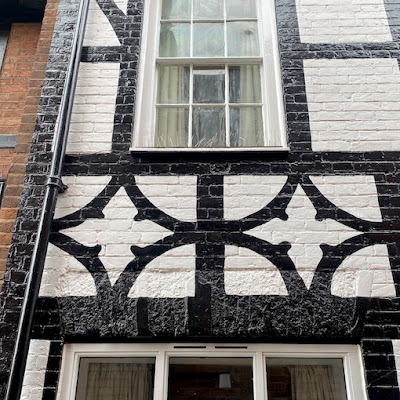Tribute bands
It’s easy to be dismissive about this sort of thing: a pattern of faux-timber framing painted on to a brick wall. ‘It’s not real,’ people say, hinting that it’s such a complete fake that it hardly exists at all. It’s the sort of thing you see quite often in counties such as Shropshire and Worcestershire, where there’s a long tradition of genuine timber-framed buildings. You’ll enter a ‘black and white’ village and stand at one end, admiring the view. Then you walk slowly forwards, realising as you go that, while many of the timbers are real, structural wood, a few are of this painted variety…and that there might also be some that are indeed genuine timber but are merely ornamental, tacked on to make the building look old.
There’s another ‘authenticity’ issue to consider when looking at this kind of thing. The familiar and much loved ‘black and white’ pattern of timber-framed buildings is itself something not quite original – most such buildings were constructed of oak that was left untreated, so that it aged to a beautiful silvery grey; infill panels were sometimes coloured with some natural pigment. Pink and grey, anyone? You can find this combination right across England now, from Tewkesbury to Lavenham.
So painted timber framing on a building like this one in a corner of Bridgnorth is obviously fake. And yet I’d not always want to remove it, to reveal the colour of the brickwork in a gesture of architectural ‘honesty’. Why? Because fake timber framing is itself now part of the history of many buildings. It is, one could argue, as much a part of the story of vernacular architecture in the West of England as oak beams and cruck frames. And it speaks of many things – an interest in history, or a respect for and tribute to the appearance of genuine timber frames, or a desire for a building to ‘fit in’. I’d not want every building to be like this, but I’m happy to find them here and there, wearing their artificial struts and showy braces with pride – and making some of us smile as we realise what’s going on.

I expect you to have a field day in good old Bridgnorth! Please don't stint.
ReplyDeleteTry: the cemetery chapels in Alpine style. Bishop Percy's house. The big church on the clifftop near the remains of the castle. The Hermitage (sandstone caves, once inhabited).
The quaint "lift" from High Town to Low Town.
Or are these to come?